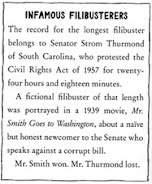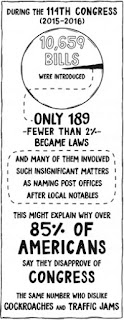Picturing the Filibuster: Infographics and Civics Education
Teaching government at the
secondary level has, in many ways, become an exercise in infographic shopping. Textbooks
routinely include digitized versions of infographics to include in instructional
lesson plans or to directly assign to students for graphic analysis. Unsurprisingly,
then, C. Levinson and S. Levinson (2019) in their critical analysis of the
Constitution include—albeit monochromatic—infographics that utilize a variety
of informal fonts presumably designed to heighten reader interest. Three of
these infographics—depicted here—could be combined to challenge students in the
secondary classroom to evaluate the filibuster and the low approval rating of
Congress by the American public.
"I Will Not Yield" from Mr. Smith Goes to Washington (1939).
To generate student attention, a
lesson on the filibuster centered upon the three graphics could start with the
clip from Mr. Smith Goes to Washington (1939) referenced in the first
image. Students could be tasked prior to starting the clip with answering the
following question: “Why might the filibuster as used by Mr. Smith be a positive
mechanism for maintaining democracy?” Once the clip is finished and students
have been provided with time to reflect upon the question, students could
discuss their responses. The importance of dialogic discourse within the
classroom has been demonstrated in numerous studies, including those of Fisher,
Frey, and Law (2021). To contrast, Mr. Smith’s filibuster, students could read
about Senator Strom Thurmond’s 1957 filibuster of the Civil Rights Act in the Washington
Post. Students could be tasked with using the article to answer the
following question: “Why might the filibuster as used by Senator Thurmond be a
negative mechanism for maintaining democracy?” Having contemplated the reasons
for having a filibuster, students could be introduced to the second image, which
illustrates how a filibuster, or the threat of a filibuster, can disrupt
legislation in the Senate. As the image makes a claim without presenting substantial
evidence, student could be challenged with identify the claim the C. Levinson
and S. Levison (2019) are making about the filibuster and utilize Gale’s
Opposing Viewpoints database to evaluate the claim. The database includes
six articles with different viewpoints on the filibuster: Harry Reid, “There
Needs to Be a Filibuster Reform to Maintain a Functioning Democracy” (2015);
Sean Trende, “Filibuster Reform Holds a Long-Term Political Advantage for
Republicans” (2015); Sanford Levinson, “Filibuster Reform is Not Enough to
Resolve US Senate Gridlock” (2015); Jim DiPeso, “The Filibuster Prevents Heated
Party Politics” (2010); David Swanson, “Both Parties Use the Filibuster to
Block the Will of the People” (2010); and Gene Healy, “Filibuster Reform Does
Note Benefit Any Party in the Long Run” (2015). After evaluating the second
image’s claim, students could be presented with the final image and challenged
with making an infographic of their own utilizing their research to determine whether
or not removing the filibuster would be enough to improve the American public’s
opinion of Congress. Students could utilize an application like Adobe Spark
Page to make their infographic. The three infographics from C. Levinson and S.
Levinson, therefore, serve as both the source of the students investigative question
and as a model for the students demonstration of understanding.
The infographics included in the
Levinson’s (2019) study of the Constitution present a critical narrative of the
filibuster, without addressing the potential benefits of the filibuster in
preventing the parliamentary tyranny often found in the Westminster system.
Additionally, the infographics do not fully explore all of the issues with the
United States Senate, including the disproportionate power given to rural areas.
While the text of the book in question does address those issues, the danger of
the graphics is that a student skimming might only read the pictures and miss
the nuances of Senate reform. As instructional tools, the infographics, as discussed
above, require further contextualization.
References
DiPeso,
J. (2010). The Filibuster Prevents Heated Party Politics. In N. Berlatsky
(Ed.), At Issue. Does the Two-Party System Still Work? Greenhaven Press.
(Reprinted from Three Cheers for Filibusters, thedailygreen.com, 2008) https://link.gale.com/apps/doc/EJ3010605212/OVIC?u=mlin_c_woracd&sid=OVIC&xid=e7628f93
Healy, G. (2015).
Filibuster Reform Does Not Benefit Any Party in the Long Run. In M. Haerens
(Ed.), Opposing Viewpoints. Government Gridlock. Greenhaven Press. (Reprinted from Washington Examiner, 2013, November 25) https://link.gale.com/apps/doc/EJ3010958226/OVIC?u=mlin_c_woracd&sid=OVIC&xid=c57c8a78
Levinson,
C. and Levinson, S. (2019). Fault Lines in the Constitution: The Framers,
Their Fights, and the Flaws That Affect Us Today. Atlanta: Peachtree.
Levinson,
S. (2015). Filibuster Reform Is Not Enough to Resolve US Senate Gridlock. In M.
Haerens (Ed.), Opposing Viewpoints. Government Gridlock. Greenhaven Press.
(Reprinted from Filibuster Reform Isn't Enough, 2014, January 12) https://link.gale.com/apps/doc/EJ3010958224/OVIC?u=mlin_c_woracd&sid=OVIC&xid=64b89b37
Reid,
H. (2015). There Needs to Be Filibuster Reform to Maintain a Functioning
Democracy. In M. Haerens (Ed.), Opposing Viewpoints. Government Gridlock.
Greenhaven Press. (Reprinted from Speech on Filibuster Reform,
http://talkingpointsmemo.com/livewire/read-harry-reid-s-full-speech-calling-for-filibuster-reform,
2013) https://link.gale.com/apps/doc/EJ3010958222/OVIC?u=mlin_c_woracd&sid=OVIC&xid=64860303
Swanson,
David. "Both Parties Use the Filibuster to Block the Will of the
People." Does the Two-Party System Still Work?, edited by Noah Berlatsky,
Greenhaven Press, 2010. At Issue. Gale In Context: Opposing Viewpoints,
link.gale.com/apps/doc/EJ3010605211/OVIC?u=mlin_c_woracd&sid=OVIC&xid=46526f01.
Accessed 11 Apr. 2021. Originally published as "2009: Year of the
Filibuster," DavidSwanson.org, 2008.
Trende,
S. (2015). Filibuster Reform Holds a Long-Term Political Advantage for
Republicans. In M. Haerens (Ed.), Opposing Viewpoints. Government Gridlock.
Greenhaven Press. (Reprinted from Why Democrats Should Fear Filibuster Reform,
2013, January 24) https://link.gale.com/apps/doc/EJ3010958225/OVIC?u=mlin_c_woracd&sid=OVIC&xid=5336e7c0



Comments
Post a Comment